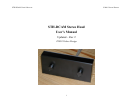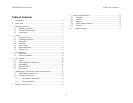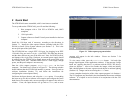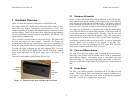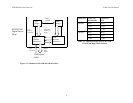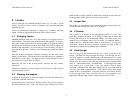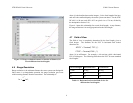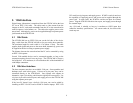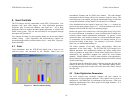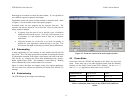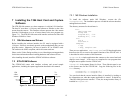STH-DCAM USER’S MANUAL 2001 VIDERE DESIGN
5 1394 Interface
Digital image information is transferred from the STH-DCAM to the host
PC via an IEEE 1394 cable. The cable sends a video stream from the
imagers to the PC, and sends commands from the PC to the stereo head to
control exposure, color balance, etc. The cable also supplies power to the
stereo head. Alternatively, power can be supplied through a separate power
jack located on the STH-DCAM.
5.1 1394 Cable
The STH-DCAM has an IEEE 1394 port on the left side of the device.
Plug a cable from the STH-DCAM into a free port on the host controller.
The maximum length for such a cable is 4.5 m (about 15 feet). The cable
supplies both signals and power to the stereo head; alternatively, power can
be supplied at the device using a separate power supply.
The distance between the stereo head and the PC can be extended by using
an IEEE 1394 repeater.
Several 1394-enabled devices can be connected together, as long as the
connection topology doesn’t have any loops. The STH-DCAM is always a
leaf of the bus. At a maximum, it will need about 60% of the bandwidth of
a 400 MBps connection.
5.2 1394 Host Interface
The host computer must have an available 1394 port. Some portables and
desktops come with built-in ports. If these are 6-pin ports, they can be
connected directly to the STH-DCAM. Sony laptops also support an
alternative 4-pin 1394 cabling, which has the signal pins but no power. Use
a 4-pin to 6-pin cable on these ports, and supply power to the STH-DCAM
using the separate power port.
If the host PC doesn’t have a built-in 1394 port, one can be added by
installing an IEEE 1394 PCI card or PCMCIA card for laptops. IEEE 1394
PCI cards have 6-pin ports, and supply power. PCMCIA cards do not have
the capability of supplying power, and power can be supplied through the
power jack. In some cases, the PCMCIA card has an input for external
power. Plug the STH-DCAM cables into a port, and supply power through
the external input.
Any 1394 card is suitable, as long as it conforms to OHCI (open host
controller interface) specifications. All current cards do, but some older
cards may not.
9



